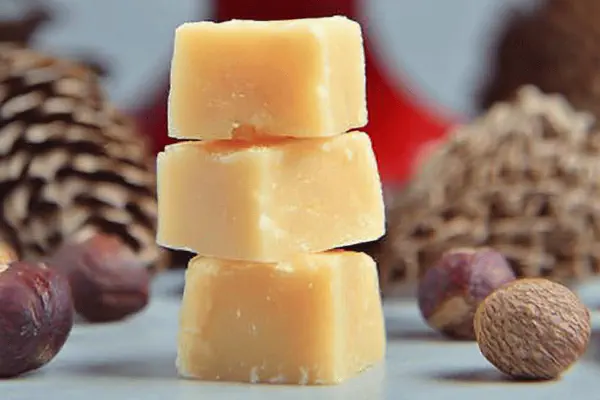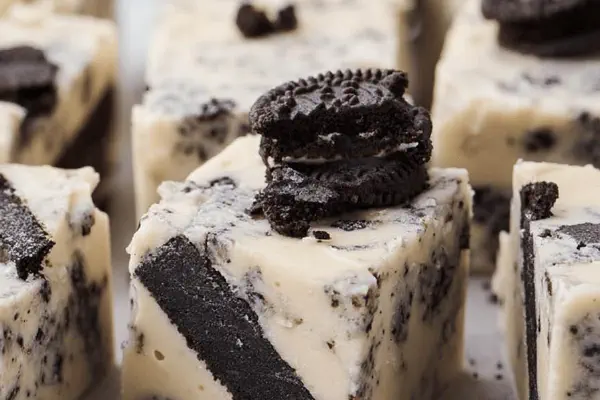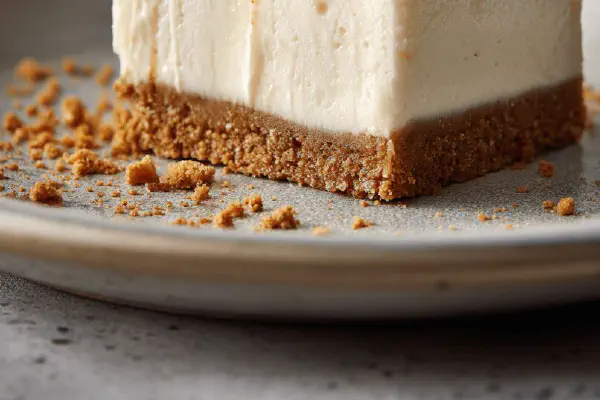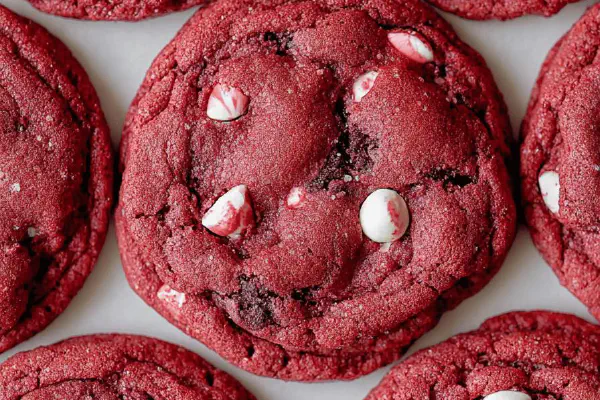Eggnog White Chocolate Fudge
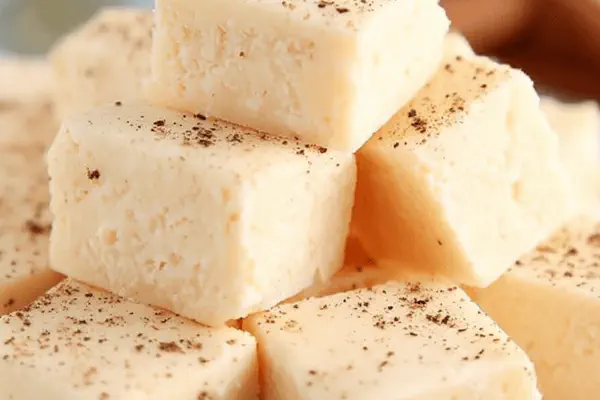
By Emma
Certified Culinary Professional
Ingredients
- 1 teaspoon ground cinnamon and nutmeg mixed (reserve ⅓ teaspoon for topping)
- 1 cup unsalted butter
- 4 ½ cups granulated sugar
- 1 cup eggnog (or substitute with half cream half milk)
- ⅔ teaspoon fine sea salt
- 1 cup marshmallow fluff or marshmallow cream (can replace with homemade marshmallow creme)
- 4 cups white chocolate chips (can use vanilla almond bark in a pinch)
About the ingredients
Method
- Mix cinnamon and nutmeg in small bowl. Save ⅓ teaspoon to sprinkle on top later. Rest goes into fudge base.
- Line a 9-inch square pan with parchment paper. Fudge sticks otherwise. No excuses here.
- Melt butter with sugar, eggnog, and salt over medium-high. Stir often. Bring to steady rolling boil. Keep it there for about 4 minutes. Watch closely — no scorch, no froth over. Temperature aiming for soft ball stage, about 237 to 239°F. If no candy thermometer, test by dropping syrup into cold water; it should form a pliable ball.
- Remove from heat. Immediately add marshmallow cream, white chocolate chips, and about ⅔ of the spice mix. Use electric mixer at medium speed. Whip until white chocolate melted, mixture thickened and glossy. Should look lighter, not grainy.
- Pour mixture into prepared pan, smooth the top quickly before it starts to set. Don’t wait, fudge sets fast once off heat.
- Sprinkle remaining ⅓ teaspoon of spice blend evenly over fudge. Gives aroma punch and subtle crunch contrast.
- Set pan on flat counter or shelf. Leave undisturbed for 3.5 to 4 hours at room temp to solidify. Don’t try fridge unless pressed; cold snaps change fudge texture, can become chalky.
- Slice with warm, clean knife. Heat knife under hot water, dry quickly on towel — cuts clean squares without cracking.
- Feedback loop from trial runs: lower sugar by 5% if you like it less sweet; cream can replace part eggnog for richer fudge; if marshmallow cream unavailable, powdered gelatin and sugar syrup can mimic texture (though more work). Tried almond extract once, weird in this combo, stick to spices.
- Watch the boil closely. Boil too short, fudge won’t set; overshoot candy stage, it gets grainy or hard. Sound changes too — that steady rolling boil, hear that rhythm? That’s fudge cooking.
- If fudge turns grainy, probably sugar crystallized. Heating too fast or stirring too hard at wrong time. Patience and steady stirring important.
Cooking tips
Chef's notes
- 💡 Boil candy mix on medium-high. Steady rolling bubble sound, not frantic froth. That rhythm? Signals soft ball stage. Timer lies. Watch sugar bubble behavior. If froths or scorches, fudge ruined. Stir slow, constant, no slacking. Temperature 237-239°F best but test with cold water blob ball if thermometer’s missing. Don’t rush cooling once poured. Let firm hours undisturbed flat surface. Patience trumps speed.
- 💡 Marshmallow cream vital. Adds fluffy silk texture; homemade marshmallow creme works too. Powdered gelatin plus sugar syrup possible backup but expect different mouthfeel. White chocolate chips must melt gradually post-boil. Mixer at medium speed folds chips and marshmallow slurry; speeds thickening, avoids grainy bite. Timing pouring critical — fudge sets fast off heat. Smooth top quick or get uneven surface.
- 💡 Butter unsalted only; salted dulls eggnog brightness. Spice mix balanced cinnamon nutmeg fine ground; reserve some for topping. The topping sparks aroma on serving and subtle crunch contrast. When lacking eggnog, half cream half milk substitute keeps texture richer and mouthfeel intact. Sugar reducible by 5% for less sweetness but affects set slightly. Salt wakes all flavors; skip it, dull fudge follows.
- 💡 Parchment line the pan snugly, corners crisp folds. Bare pan fudge sticks relentlessly. Slice fudge with warm knife cleaned between cuts; heating knife under hot water and drying fast prevents crumbly edges. Fridge tempting but cold snaps create chalky texture; room temperature and time required. Cut only after firm set—3.5 to 4 hours minimum. Don’t nudge fudge while cooling; movement creates cracks.
- 💡 Listen during boil — sound changes matter. Early boil too soft, fudge fails to set. Overboil? Grainy or brittle crystals. Sugar crystallization causes gritty, sandy texture; usually stirring too fast or heat spike. Constant gentle stirring and eye on boil avoids. Almond extract tested once; weird clash. Stick to cinnamon nutmeg combo for classic warmth. Mixing spices fresh ground pulls deeper aroma than pre-ground variety.
Common questions
How to know when fudge is done boiling?
Listen for steady rolling boil, no froth. Sugar bubbling rhythmic. If bubbling too soft, fudge won’t set. Too hard or long boil brings grainy texture. Cold water test works if no thermometer; syrup blob forms pliable ball. Timing not exact; feel and sound key here.
Can I replace marshmallow cream?
Yes, homemade marshmallow creme substitute works well. Powdered gelatin and sugar syrup possible but texture changes. Marshmallow cream adds fluffiness and smoothness; skip it loses silk mouthfeel. Don’t sub with mini marshmallows; too rough and dry.
Why is my fudge grainy?
Sugar crystallization culprit. Stirring too hard or fast during boil disrupts syrup. Also over-boil or letting syrup cool slightly before folding in chips causes grain. Keep boil steady, stir moderately, remove heat promptly. Re-melting grainy fudge doesn’t fix texture usually.
Best way to store fudge?
Wrap tight in parchment or foil, store room temperature for up to two weeks. Fridge causes chalky texture but short term okay if wrapped well. Freeze possible but texture may change after thaw. Avoid moisture or air exposure to keep chew intact.
